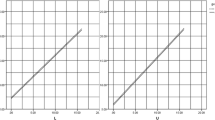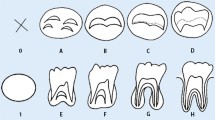Summary
The estimation of chronologic age based on the stages of third-molar development was evaluated by using the eight stages (A-H) method of Demirjian and the third-molar development was compared, in terms of sex and age, with results of previous studies. The samples consisted of 291 orthopantomograms from young Chinese subjects of known chronologic age and sex (including 139 males with a mean age of 14.67±3.62 y and 152 females with a mean age of 14.85±3.70 y). Statistical analysis was performed by employing the Mann-Whitney U-test and the t-test. Regression analysis was conducted to obtain regression formulas for calculating dental age from the chronologic age. Our results showed statistically significant differences (P<0.05) in third-molar development between males and females, at the calcification stages D, E and H. And a strong correlation was found between age and third-molar development in both males (r 2=0.65) and females (r 2=0.61). New equations (Age=8.76+1.32 Development stage) for estimating chronologic age were derived. It is concluded that third-molar genesis took place earlier in males than in females. The use of third molars as a developmental marker is appropriate in young adults of Central China. The formula obtained in the present study can be used as a guide for estimation of dental maturity and a standard for age estimation for young adults of Central China.
Similar content being viewed by others
References
Ritz-Timme S, Cattaneo C, Collins M J et al. Age estimation: the state of the art in relation to the specific demands of forensic practice. Int J Legal Med, 2000,113:129–136
Willems G. A review of the most commonly used dental age estimation techniques. J Forensic Odontostomatol, 2001,19:9–17
Thorson J, Hägg U, The accuracy and precision of the third mandibular molars as an indicator of chronological age. Swed Dent J, 1991,15:15–22
Demirjian A, Goldstein H, Tanner J M. A new system of dental age assessment. Hum Biol, 1973,42:211–227
Levesque G Y, Demirijian A, Tanguay R. Sexual dimorphism in the development, emergence, and agenesis of the mandibular third molar. J Dent Res, 1981,60:1735–1741
Nyarady Z, Mornstad H, Olasz L et al. Age estimation of children in south-western Hungary using the modified Demirjian method. Fogorv Sz, 2005,98, 193–198
Chaillet N, Willems G, Demirjian A. Dental maturity in Belgian children using Demirjian’s method and polynomial functions: new standard curves for forensic and clinical use. J Forensic Odontostomatol, 2004,22:18–27
Li X H. Bio-anthropology. Guangzhou: Publishing House of Sun Yat-sen University (Chinese), 2007.73–75
Melsen B, Wenzel A, Miletic T et al. Dental and skeletal maturity in adoptive children: assessments at arrival and after one year in the admitting country. Ann Hum Biol, 1986,13:153–159
Kullman L. Accuracy of two dental and one skeletal age estimation method in Swedish adolescents. Forensic Sci Int, 1995,75:225–236
Gleiser I, Hunt E E. The permanent mandibular first molar; its calcification, eruption and decay. Am J Phys Anthropol, 1955,13:253–284
Olze A, Taniguchi M, Schmeling A et al. Comparative study on the chronology of third molar mineralization in a Japanese and a German population. Leg Med, 2003,5:256–260
Köhler S, Schmelzle R, Loitz C et al. Entwicklung des Weisheitszahnes als Kriterium der Lebensalterbestimmung. Ann Anat, 1994,176:339–345
Orhan K, Ozer L, Orhan A et al. Radiographic evaluation of third-molar development in relation to chronological age among Turkish children and youth. Forensic Sci Int, 2007,165:46–51
Dhanjal K S, Bhardwaj M K, Liversidge H M. Reproducibility of radiographic stage assessment of third-molars. Forensic Sci Int, 2006,159:74–77
Uzamis M, Kansu O, Taner T U et al. Radiographic evaluation of third-molar development in a group of Turkish children. ASDC J Dent Child, 2000,67:136–141
Arany S, Iino M, Yoshioka N. Radiographic survey of thirdmolar development in relation to chronological age among Japanese juveniles. J Forensic Sci, 2004,49:534–538
Daito M, Tanaka M, Hieda T. Clinical observations on the development of third molars. J Osaka Dent Univ, 1992,26:91–104
Gorgani N, Sullivan R E, DuBois L. A radiographic investigation of third-molar development. ASDC J Dent Child, 1990,57:106–110
Harris E F, McKee J H. Tooth mineralization standards for blacks and whites from the middle southern United States. J Forensic Sci, 1990,35:859–872
Author information
Authors and Affiliations
Additional information
Yuming BAI, male, born in 1977, Doctoral Candidate
Rights and permissions
About this article
Cite this article
Bai, Y., Mao, J., Zhu, S. et al. Third-molar development in relation to chronologic age in young adults of central China. J. Huazhong Univ. Sci. Technol. [Med. Sci.] 28, 487–490 (2008). https://doi.org/10.1007/s11596-008-0426-9
Received:
Published:
Issue Date:
DOI: https://doi.org/10.1007/s11596-008-0426-9




